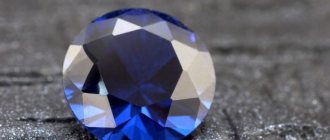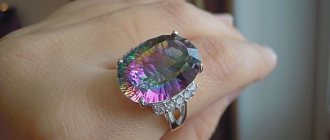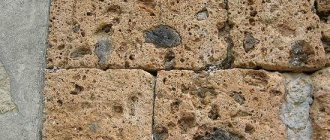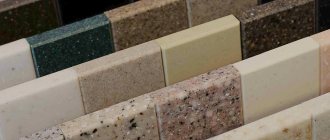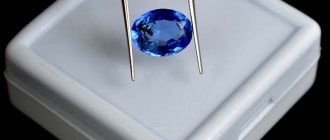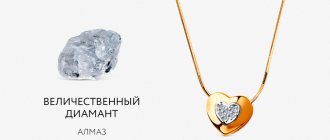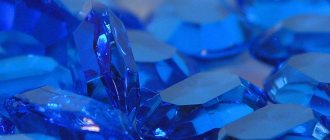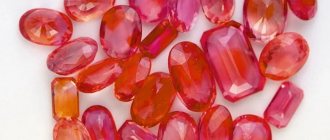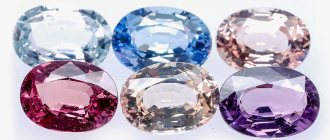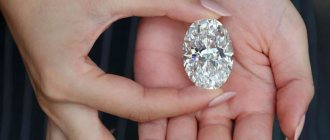History and origin
Star sapphire is a gemstone that has a dense, opaque color and a special asterism (star) effect. That is, a six-pointed star is clearly visible on its surface, the rays of which form rutile inclusions. In other words, it is crystallized titanium oxide, having a needle shape. In cross-section, each of the crystals has the shape of a triangle.
Blue Star Stone
Due to the fact that the rutile needles are located at an angle relative to each other, a six-pointed star is formed. There are three intersecting axes in the stone.
In the Middle Ages in Russia, sapphire, along with rubies, was called yakhont . It’s not for nothing that the affectionate expression “my yacht” is known. At the same time, the sapphire was called the azure yakhont, and the ruby was called the scarlet yakhont.
In order for the optical effect on the surface of the stone and the color of the star sapphire to appear in all its glory, jewelry craftsmen prefer to give the gem a cabochon shape. On the one hand, this is a method of jewelry processing of a mineral, and on the other hand, this is a stone with a rounded convex shape. Due to its roundness, all the optical effects of the mineral are more pronounced in the rays of daylight and artificial light.
What is a star sapphire
Sapphire is a gemstone, a type of corundum, its color can range from pink to blue and black. Star sapphire is a stone that contains rutile impurities.
Rutile impurities look like needle-like inclusions, which when exposed to light become like stars. This optical effect is called asterism. Asterism is inherent not only to sapphire, but also to other stones (spinel, quartz, garnet).
Physicochemical characteristics
Star sapphire is endowed with certain physical and chemical properties, for which master jewelers love it. Weight, density, color and other parameters are taken into account.
| Formula | Al2O3 |
| Color | Various shades of blue, pink, yellow, green, lavender, gray, black |
| Shine | Glass |
| Transparency | Transparent to opaque |
| Hardness | 9 |
| Cleavage | Absent |
| Kink | Rough to conchoidal |
| Density | 3.95 - 4.00 g/cm³ |
Varieties and colors
The specific shade of sapphire gemstones depends on the impurities of various metals in it. The following stones are found in nature:
- Blue star sapphire. The shade is obtained due to impurities of iron and titanium. This color of stone is considered classic and the most common. Moreover, a stone can be accurately called blue only if the level of other shades in it is no more than 15%. In other cases, sapphire is rarely fully blue. The color range often varies from almost white or pale blue to deep blue (almost black). The most expensive blue sapphire is considered to be the one that has a cornflower blue or heavenly color.. If a mineral contains a large number of iridescences of other shades, it is called fancy. It is sometimes difficult to find a good match for such a mineral.
Sky Blue Star Stone - Black. Black gemstones are more common in nature because they contain atomic impurities. The largest sapphire was black in color. Upon examination, the mineral has a dense color and a low level of transparency. The edges give reflections of light and shimmer. Jewelry with black stone is laconic and strict.
Gold ring with black star stone - Yellow. This shade of stone is given by an admixture of iron without the inclusion of titanium. Yellow sapphire can be compared in cost to expensive cornflower blue stones. The color of the mineral varies from almost transparent or pale yellow to rich amber. The yellow yacht is of particular importance in the cultures of Hindus and Eastern peoples. It is believed that if a yellow sapphire has even the slightest defect, it is prohibited to wear it.
Yellow gold ring with yellow star stone - Pink. A stone of this color predominates in the sapphire deposits of Sri Lanka and Madagascar. The color is affected by the chromium admixture in it. The hue of the yacht is soft and delicate. Sapphire is often compared to a diamond. However, the price of the stone is several times lower than that of a precious stone. That's why pink sapphire is so popular.
Pink star stone - Violet (aka lilac or lilac). The color and its intensity depend on the concentration of vanadium in the mineral.
Lilac Star Stone - Green. Upon closer inspection through a microscope, you can see that the shade of green sapphire comes from stripes of blue and yellow, superimposed on each other.
Green Star Stone - Colorless. A stone with high transparency. The shine is similar to that of a real diamond. Jewelers often use diamonds as the main stone and colorless sapphires as additional stones. Such a product will cost slightly less than jewelry encrusted only with diamonds.
White Star Stone - Padparadscha. One of the sapphire hybrids. Its shade is compared to a pink sunset or molten gold - the yellow, orange and pink-red shades shimmer in it in such an original way. Padparadscha means "delicate lotus flower" in Sinhala.
The unusually colored star stone Padparadscha
Padparadscha is the least likely to have natural defects. You can appreciate the depth of sapphire color in calm morning or evening sunlight.
Colors and uniqueness of the star gem
The aluminum oxide that creates the stone is achroic, that is, colorless. But the tonality of natural sapphires with asterism ranges from pinkish to blue-black. Plus combined options. There are no only red sapphires. Corundums of this color are rubies.
The difference in the color of gems is created by impurities:
- iron plus a little vanadium - reddish-yellow-orange shades (more about yellow);
- high content of vanadium – violet, lilac-lilac;
- a lot of iron - green;
- the prevalence of impurities is grayish, even black.
The star is white or whitish with an admixture of another color.
Rare and expensive – green gem. The most popular is the classic blue sapphire. Mostly ferrous minerals are mined. Thailand's stones with a golden star are considered elite.
A star sapphire is more valuable than a similar ruby. On it, the 12-pointed star is more common, it is clearer, smoother and brighter.
Place of extraction
Jewelry with star sapphires has different prices. And it depends not only on the type of metal in which the yacht is framed, but also on the deposit of the gem. Placers of sapphires are found in the following places:
- Sri Lanka;
- USA;
- Vietnam;
- Madagascar;
- Australia;
- Thailand;
- China;
- Burma.
In Russia, sapphire is found only together with blue corundum. Transparent yachts are found in it. There are corundum deposits on the Kola Peninsula and in the Urals.
Raw Blue Star Yakhont
Important: the price per carat of star sapphire depends on its deposit. The most expensive stones are those from Burma and Sri Lanka. However, you can also buy less “famous” yachts that have a lower cost but decent quality.
History of the stone
Star sapphire (often called star or star stone) has been known since ancient times. It was first found in Ancient Asia. It was believed that the stars are frozen drops of the elixir of immortality.
There are 2 main versions of the origin of the name of the mineral:
- the name comes from the ancient word “sipru” - “scratching” (due to its high hardness);
- from the Greek word sappheiros - “blue stone”.
It is believed that the stone has a divine purpose and is able to slow down the aging process of the body.
Magic properties
The magical properties of star sapphire have always aroused genuine interest among scientists and gemologists, magicians and astrologers. It is believed that the gem contains the magic of the cosmos. Some even claimed that the six-pointed star on the sapphire was nothing more than a hexagram. Therefore, the star yacht is given special magical significance. It manifests itself in the following:
- Strengthening memory and passion for new knowledge. The gem is especially suitable for students and teachers.
- Achieving goals and overall personal development. As a male amulet with this effect, you need to wear the stone on your left hand.
- Extinguishing passions and bringing emotions into a calm channel.
- Harmonization of relations.
- Neutralizing laziness and revealing some persistence.
- In addition, the star stone determines true friends, or rather, over time, weeds out the insincere clingers that have wormed their way around.
In ancient times in Africa, it was believed that the rays of crystals in stone are symbols of Faith, Hope and Love intersecting. That is, a star sapphire brings only the best to the owner’s life.
Artificial star stones
They learned to obtain the effect of asterism artificially. Such stones are easily distinguished by their impeccable star geometry.
The second sign is that the rays of a man-made star are motionless, regardless of the angle of the incident light. In the natural original they are dynamic.
Production is difficult and expensive, so there are few such stones on the market. A synthetic fake with impeccable asterism can be more expensive than a lower-quality natural analogue. However, it has no healing or magical properties.
Who is suitable according to their zodiac sign?
The gemstone is suitable for almost all zodiac signs, but to a greater or lesser extent. The meaning for the signs is almost neutral, so each of the representatives of the astrological circle can safely wear a star yacht.
| Zodiac sign | Compatibility |
| Aries | + |
| Taurus | + |
| Twins | + |
| Cancer | + |
| a lion | + |
| Virgo | + |
| Scales | + |
| Scorpion | + |
| Sagittarius | +++ |
| Capricorn | — |
| Aquarius | +++ |
| Fish | + |
(“+++” – fits perfectly, “+” – can be worn, “-” – is strictly contraindicated)
Compatibility with other stones
If a natural sapphire is an amulet or a favorite everyday decoration that you don’t want to take off, then you can organically combine the gem with the following stones:
Silver long earrings with blue star yakhont and topaz
- diamond;
- aventurine;
- amethyst;
- aquamarine;
- turquoise;
- rock crystal;
- Moonstone;
- jasper;
- chrysoprase;
- ruby;
- pomegranate.
It is important that the shade of the leading sapphire matches the secondary stone. It is highly undesirable to combine the gem with sardonyx, agate and jade.
Where is it used?
Star stones are used only for caboching. That is, they give the gem a round, convex and smooth shape. Jewelers themselves call it a high domed stone. Moreover, the master often violates the geometry of the proportions of the yacht in order to preserve the beauty of the six-pointed star in its depths.
Depending on the size of the gem, it is used as an insert in rings and especially large rings, earrings, and pendants. The higher the cost of the precious metal and the larger the size of the mineral, the higher the cost of the product. Cool shades of sapphire look ideal in silver and platinum, while warm shades of the stone are ideally combined with gold. Both men and women should wear jewelry with it. But it is worth remembering that these are often large products.
Stylish silver set with a purple star yacht
In addition to jewelry, the gem is usually used for inlaying mirror frames, boxes and other personal and interior items.
How to spot a fake
When purchasing, it is important to distinguish a synthetic gem from a genuine one. And although they have not yet learned how to artificially grow a stone with a star pattern, experienced scammers in street stalls manage to pass off a fake plastic stone as a sapphire with an optical pattern. The main distinguishing features of a genuine yacht are:
- Hardness. Even if the surface of a real stone is scratched with metal, it will remain smooth.
- Density. Real stone has a higher density than water. Therefore, when immersed in water, it immediately falls to the bottom. The fake will stick to the surface.
- The presence of inclusions in the cavity of the gem. They can be seen with a magnifying glass.
It is unlikely that you will be allowed to do all the manipulations with the stone in the store. Therefore, to assess its authenticity, it is better to use the services of a professional jeweler.
How to choose a good copy and distinguish it from a fake
There are several rules that will allow you to distinguish a natural gem from a fake:
- a real gem has a certificate of conformity;
- it is very hard and cannot be scratched;
- if you put a mineral in a glass of water, it will instantly appear at the bottom;
- its color is uneven;
- the cost of a star gem cannot be less than 20,000 rubles per carat.
In addition to the natural mineral, the jewelry market offers artificial sapphire, which has a bright color and perfect shine. The synthetic mineral is grown in laboratory conditions, using chemical elements to give it the desired color and shine.
Differences from natural gems:
- under the influence of ultraviolet radiation, the synthesized mineral will appear green;
- the star of a natural mineral will move along the surface when rotating, while that of an artificial one will remain in place;
- a natural mineral will not have a perfectly even structure and color.
In addition to artificial ones, there are also ennobled specimens, which are heated to obtain a bright color or fill voids and cracks in it with wax. In fact, such a copy is not considered a fake, but information about the manipulations performed is reflected in the certificate, and its price is lower.
Favorable time to buy
It is better to buy a precious yacht in the first phase of the Moon. During this period, the mineral has less (increasing) energy, and therefore will enter into a relationship with a new host. That is, it will be saturated with the energy of the new owner. Favorable numbers for buying sapphire are from the 8th to the 22nd.
When purchasing a stone separately, it is not recommended to place it on your palm. They look at the gems only by holding them in their fingers. And remember, “your” stone will wear perfectly. Energetically, it is not your gem that will constantly interfere, strain, subside or crush.
